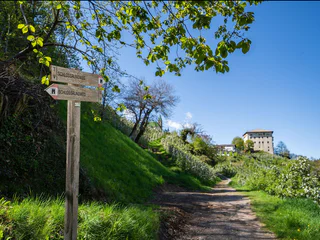
1/6
Castle Circular Trail
Prissiano/Prissian, Tisens/Tesimo, Meran/Merano and environs
Všude v prázdninových regionech Jižního Tyrolska jsou vyznačeny tematické procházky, speciální objevitelské trasy pro malé i velké. Například v jihotyrolském Unterlandu mohou návštěvníci na podzim zažít, jak se hrozny dostanou z vinné révy do sudu. V San Valentinu v Campo/Gummeru můžete prozkoumat vesmír a naši sluneční soustavu a v Terlanu/Terlanu pěstitelé chřestu předvedou, jak se na jaře získává ze země vzácný chřest. Celkem na návštěvníky Jižního Tyrolska čeká více než 150 značených a poučných tematických procházek.

1/6
Prissiano/Prissian, Tisens/Tesimo, Meran/Merano and environs

San Nicolò/St. Nikolaus, Ulten/Ultimo, Meran/Merano and environs

1/2
Braies di Fuori/Ausserprags, Prags/Braies, Dolomites Region 3 Zinnen

1/2
Cologna/Glaning, Jenesien/San Genesio Atesino, Bolzano/Bozen and environs

1/3
Obereggen/Obereggen, Deutschnofen/Nova Ponente, Dolomites Region Eggental

Bressanone città/Brixen Stadt, Brixen/Bressanone, Brixen/Bressanone and environs

1/2
San Cassiano/San Cassiano, Badia, Dolomites Region Alta Badia

1/3
S. Vito/St. Veit - Braies/Prags, Prags/Braies, Dolomites Region 3 Zinnen

San Nicolò/St. Nikolaus, Ulten/Ultimo, Meran/Merano and environs

1/2
Colma/Kollmann, Barbian/Barbiano, Brixen/Bressanone and environs

1/3
Juvale/Juval, Kastelbell-Tschars/Castelbello-Ciardes, Vinschgau/Val Venosta

1/5
Valgiovo/Jaufental, Ratschings/Racines, Sterzing/Vipiteno and environs

Bressanone città/Brixen Stadt, Brixen/Bressanone, Brixen/Bressanone and environs

1/6
Mazzon/Mazon, Neumarkt/Egna, Alto Adige Wine Road

Caerna/Garn, Feldthurns/Velturno, Brixen/Bressanone and environs

1/3
Sluderno/Schluderns, Schluderns/Sluderno, Vinschgau/Val Venosta

1/3
Obereggen/Obereggen, Deutschnofen/Nova Ponente, Dolomites Region Eggental

Rencio/Rentsch, Bolzano/Bozen, Bolzano/Bozen and environs

Colle Isarco/Gossensaß, Brenner/Brennero, Sterzing/Vipiteno and environs

1/5
Monguelfo/Welsberg, Welsberg-Taisten/Monguelfo-Tesido

1/5
S. Osvaldo/St. Oswald - Bolzano/Bozen, Bolzano/Bozen, Bolzano/Bozen and environs

1/3
Monte di Tramontana/Nördersberg, Schlanders/Silandro, Vinschgau/Val Venosta

Stelvio/Stilfs, Stilfs/Stelvio, Vinschgau/Val Venosta

1/3
Corvara/Corvara, Corvara, Dolomites Region Alta Badia

S. Martino al Monte/St. Martin - Laces/Latsch, Latsch/Laces, Vinschgau/Val Venosta

1/7
Alpe di Rodengo/Rodenecker Alm, Rodeneck/Rodengo, Brixen/Bressanone and environs

San Pancrazio/St. Pankraz, St.Pankraz/San Pancrazio, Meran/Merano and environs

1/3
Corvara/Corvara, Corvara, Dolomites Region Alta Badia

1/4
Soprabolzano/Oberbozen, Ritten/Renon, Bolzano/Bozen and environs

1/3
S. Michele/St. Michael - Castelrotto/Kastelruth, Kastelruth/Castelrotto, Dolomites Region Seiser Alm